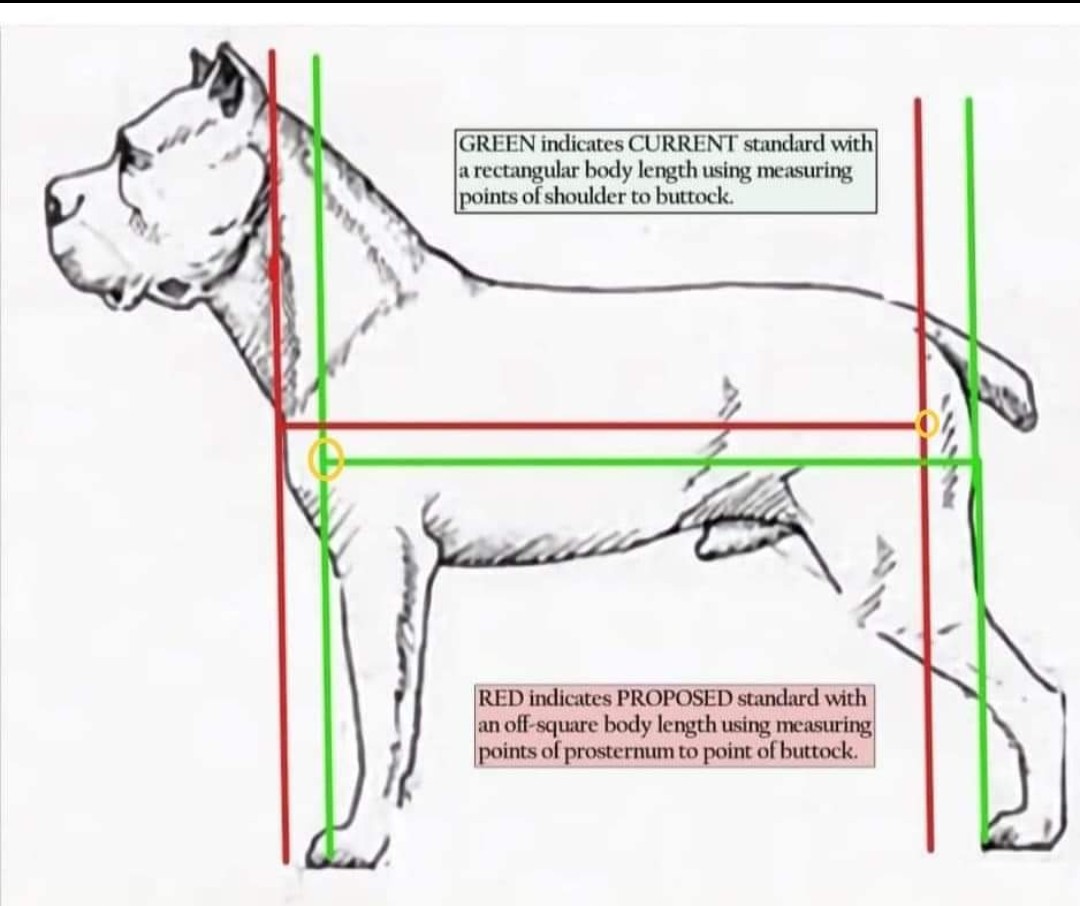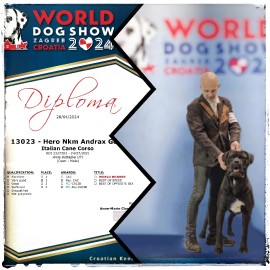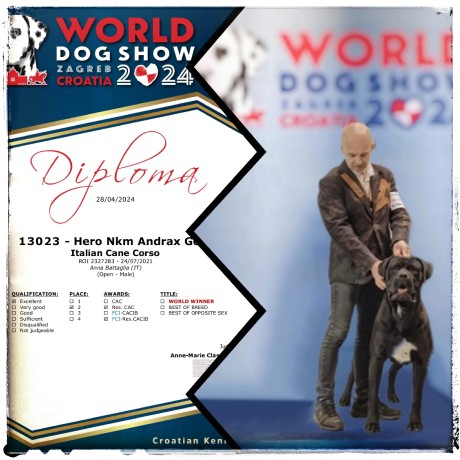
CLEAR words and info about body of Cane corso by Nicola Mille

CHANGES THAT ARE AMERICAN OR AMERICANIZED? THE LATTER FITS
While I normally avoid delving into a topic if it originates from a single photograph or drawing, and in particular if it originates on social media, there are exceptions. And this is one of them that at least requires clarification. Or, instead, a position that doesn’t allow silence to support absolute nonsense.
We have, at the root of this discussion, a drawing of a Cane Corso in profile. (Put aside how correct the illustration of the dog itself is — that’s not the point.) On this illustration, some lines are drawn in red, and some in green. With both colors, there is a vertical line in front of the dog, another vertical one behind the dog, and a horizontal line connecting them.
Referring to the green lines, comments on the photo note that they represent the current Cane Corso standard, which uses the point of shoulder and point of buttocks to measure the length of body.
The illustration’s comments about the red lines say that they reflect the proposed changes to the AKC standard, which use the point of sternum and point of buttock to measure length of body. The comments say that this will result in an off-square profile — in other words, square or tending to square.
The caption states that the CCAA’s proposal to change the current AKC Corso standard will fundamentally change the Cane Corso breed, which has always been a breed that is rectangular in profile.
Now, I have a real and serious difficulty even just thinking that all this, from the drawing to the red and green lines to the explanations and captions, is real, and have could have any official connection to the AKC or CCAA.
I say this because not a single element of these parts, not the drawing or the words, have any cynolognostic or cynometric logic or correctness. It looks like a drawing done by an elementary-school child, or during bar chatter between wanna-be football coaches.
It’s really difficult for me to believe that commentary on a standard of a foreign, non-American breed could have as its starting point such ignorance of every basic rule of cynometrics, landmarks and body proportions. If I then remember that the original Cane Corso standard is absolutely one of the most detailed and complete in the world in terms of descriptive and technical details, when I look at this drawing I don’t know whether to laugh or cry.
While awaiting my decision between tears and smiles, let me try to explain the source of my difficulty.
The original standard says that the Cane Corso has a body length, measured from the tip of the shoulder (external scapular humeral angle) to the tip of the buttock (posterior tip of the ischium” that exceeds the height at the withers by 11 percent.
It means that, for example, in a male that is 68 cm tall at the withers, an ideal body length would be 68 + 7.48 cm long — that is, 75.48 centimeters.
Let’s stick to this kinometric measurement for a first consideration.
When measurements were made on dozens and dozens and dozens of original subjects – measurements that were then cataloged, processed and used to write the definitive standard by an expert judge and dog technician such as Prof. Antonio Morsiani, assisted by other fellow judges equally expert in both Italian and in the committee of the international cynological federation – a very precise and particular measurement was indicated: 11%. A banal and common 10% has never been written in a simpler way.
It must be clear that in a 68 cm-tall subject, the difference in body length between 10 and 11 percent is 0.68 cm. So basically, visually, just over half a centimeter – in inches, a quarter-inch. We are talking about a 68 cm tall specimen that goes from 75.48 cm in body length to 74.8 cm.
And we are referring to a male at the correct maximum size limit according to the standard.
Even if he were 75 cm tall, the difference between 11% and 10% remains 83.5-82.5 – just one centimeter of length (3/8 of an inch) on a body that is always at least 82 centimerers long.
One centimeter! Not even half an inch!
It should be clear to even the most ignorant commentator on cosmic nothingness that putting a precise measurement like 11% in the standard instead of a generic and banal 10% does not have a numerical meaning but a visual and conceptual one!
It means translating an obligation of breed type into numbers: The Cane Corso is and must remain a breed that must never give the impression, when looking at it in profile, of being square. Not only must it not be so in measurement, but it must not even appear like a dog tending toward a square. This is the conceptual meaning of that 1%!!!
This is a breed that – in order to be functional, typical and respectful of its history and origin, in order to have the correct movement of a fast trotter with fractions of canter – clearly needs to remain, cynometrically and visually, in a rectangular format.
It should also be remembered that cynometrically, those breeds that are considered to be square have a body length that does not exceed the height at the withers by more than 8%. And this underlines even more the reason and the use of an 11% compared to a generic 10%. Never the slightest bit tending to the square!
Let's remember that there is a tolerability margin of two centimeters in height. This tolerability disappears in the length, where not only do we already start with a +2% compared to the quadrature of 8% but we eliminate it by increasing it to a mandatory +3%.
Before anyone tries to object to the fact that this "obligatory definition of structural type" could lead to dogs that are too long, another clarification is necessary: No concept expressed in a complete and detailed standard is separate from all the others.
The standard also says that the Cane Corso must have a long and evident withers, raised, with a well-sloping shoulder and a humerus slightly longer than the shoulder. It says that the height from the withers to the elbow is equal to the distance of the elbow from the ground. And it says that the loin is short, as wide as it is long.
Therefore, if any dog is too long, it will be due to an understated withers, a straight shoulder or a short forearm. Or that dog will have a long, narrow loin.
Of course, such dogs do not become incorrect due to the overall and generic length of the entire body. Proposing a change in the proportions of the body in order to remedy other structural defects is not only wrong from a cynometric point of view, but also very childish and superficial from a logical and functional point of view.
The solution is never to change a standard but to improve the quality of your dogs, bringing them closer to the optimum described by the standard. Or, possibly, change breeds.
But let's move on to the lines drawn on the drawing and start with the red ones, which, as I already said, according to whoever drew them, should be those that indicate the current standard, which rightly uses the point of shoulder and point of buttock to measure the rectangular torso. And this, in terms of writing, is correct, because the original standard says precisely that the Cane Corso has a body length measured from the tip of the shoulder (external scapular-humeral angle) to the tip of the buttock (posterior tip of the ischium).
However, the lines drawn to indicate what is written are not correct. To be more precise, one of the two lines is not, because while the rear vertical line is rightly positioned on the rearmost tip of the buttock, the front line, which should be overlapped with the tip of the shoulder, in the drawing is instead moved further back than to the correct landmark.
Landmarks, if you are not clear on what they are, represent in anatomy a precise area on the surface of the skin that corresponds exactly to anatomical parts that are easily identifiable and recognizable. And they are also used in cynognostics and cynometry to have starting and arrival points for straight lines that are always defined, and which give measurements that can always be objectively evaluated.
The external scapular-humeral angle, commonly called the point of the shoulder, is the frontally most advanced point on the central line of the scapula, positioned at the joint between the scapula and the humerus. It cannot be, as in the drawing, inside the body, but is located on the edge of the anterior profile of the limb, at the most advanced point of the joint. What is indicated in the drawing, circled in yellow, given by the intersection between the vertical front green line and the horizontal one, is not the tip of the shoulder but a random point, without any stable and evident reference.
It is essential to remember that in the Cane Corso, the tip of the sternum is positioned just above the tip of the shoulder, but on the same vertical, and that it must absolutely not be prominent forward but only visible. In a vertical line, the position of the sternum and tip of the shoulder are almost superimposable.
The Cane Corso must not have a prominent chest in the front; to be clear, it has no similarities with Boxers or Dobermans. For this reason, on the practical side, if correctly traced on a drawing or visualized by looking at the profile of a live dog, using the tip of the shoulder or that of the sternum as a reference point does not change anything about the body proportions obtained.
Again, because both these points can be superimposed, the front vertical line drawn in green should have been superimposed on the similar line in red, relating to the "change," which according to whoever drew it, should pass through the tip of the sternum. And in fact, this red front vertical line is drawn correctly and passes over the tip of the sternum. But it also passes over the tip of the shoulder, as it should be in the Cane Corso.
The first mistake in drawing the green lines for a phantom change to the standard is that the tip of the sternum is above the tip of the shoulder. And while the tip of the shoulder and the buttock are optimally at the same height from the ground, connecting the sternum with the buttock implies that the connection line that visually crosses the trunk is no longer horizontal, and therefore the measurement obtained is not cynognostically reliable.
And even less so visually when looking at a live subject: If the sternum were lower, at the same height as the shoulder, you would have a subject with a narrow chest. If, however, the point of the buttock was higher up, at the same height as the sternum, you would have a horizontal croup and no longer slightly inclined, like that of a terrier or, possibly, a Doberman.
In practice, to be able to correctly measure the length of the trunk using the sternum and buttock as reference points, you should have dogs that are structurally poorly constructed, non-standard, and devoid of breed characteristics. Also in this case, no information contained in the standard can be separated from all the others, and as always, rather than modifying the standard it would be appropriate to understand it and, if it is not appreciated, change breeds.
But the biggest error in drawing the red lines indicating an imaginatively proposed change in the standard lies in the rear vertical line. This line, even in the hypothetical change, should be vertical above the tip of the buttock. And in this drawn image, I honestly don't know what to say. If it didn't seem like a serious thing, I could simply ask: What do we do with the other piece of the hind limbs then? Everything after the indicated point? Do we throw it away and provide the dogs with a cart with wheels to move around?
Of course I'm joking, I'm being ironic. But in my defense, it must be said that I didn't start telling jokes.
Let's try to understand each other, in a simple and understandable way, even for those who have absolutely no knowledge of geometry or biology or cynophilia or cynognostics.
It is said that the length of the body, of the entire body, is measured from the tip of the shoulder (and/or sternum) which is the lateral point positioned furthest in front of the trunk, up to the tip of the buttock, which is the point positioned furthest back of the trunk. So, someone explain to me how to measure this total length if you stop counting the centimeters halfway up the thigh, in the center of the dog's thigh? Maybe because in a hypothetical vertical line from that crossing point of the red lines, also circled in yellow, is the tip of the ischium? Yes, that’s true. But it is the starting point of the ischium, the spinal column is finished!!!! The measurement should be taken at the final point of the buttock, where the bone ends, not where it begins! Otherwise, what you measure is the length of the body... minus one piece!
In conclusion, both in the case of the green team and in the case of the red team, I think that there would be serious things to consider, but they are very different, and before embarking on battles both in offense and in defense of a standard that is an all-round flagship of dog-breeding world, we should at least have a tenth of the competence and knowledge of whoever wrote it, trying to remain humble. Otherwise, you run the risk -- or the certainty – of appearing stupid.
You are welcome to see the 3D video by Nicola Mille when you should understand what about we talking:


